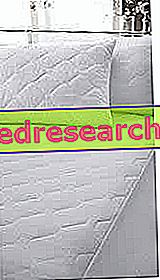Dust Mites
Mites and their derivatives are responsible for one of the most important perennial allergic reactions. In predisposed subjects, allergy to dust mites is manifested by inflammation of the respiratory tract, eye diseases and dermatitis.

The two most common species of mites are Dermatophagoides pteronyssinus and Dermatophagoides farinae, both widespread throughout the world. In our homes, the Dermatofagoids live in dust and in places where they can settle (mattress, blankets, curtains, carpets, cushions, stuffed animals etc.). A mite produces 6 to 40 faecal pellets per day: each of these contains about 0.2 ng of allergen. Other allergenic substances are proteins present in the animal's body (cuticle, sexual glands, various secretions) and in feces. These allergens can easily fluctuate in the air and, when they fall back, settle on everyday objects, then be inhaled.
How to eliminate them
Given that it is not possible to exterminate dust mites, there are several preventive measures to effectively reduce allergens in the home and thus control the allergy caused by these substances.
The best anti-mite strategies are those that act on the fundamental subsistence conditions of the offending organisms:
Mites live well at temperatures above 20 ° C.
- If the temperature is below 16 ° C, their life cycle is reduced to around 34 days. However, the mites survive, even if with fatigue, up to 0 ° C.
The relative humidity between 60% and 80% favors the proliferation of mites
- One of the main factors limiting the development of the colony is the availability of water (by absorption): if the relative humidity falls below 50-55% and the environment is dry, the mite dehydrates and dies. The best strategy is to use air conditioners (in the summer months) and dehumidifiers (in winter), setting the humidity value to 50%.
Absence of solar rays
- Mites are photophobic (they die when exposed to sunlight).
Other considerations:
- Curtains, upholstered furniture, velvet upholstery, stuffed animals etc. serve as a reservoir for mites. Duvets, sheets and mattresses are the favorite places for their establishment.
- The diet of dust mites is varied. The primary source of food consists of small skin scales, dandruff and hair. However, the nutrients needed for the mite can also be provided by fungi, molds, certain types of bacteria, insect fragments, pet food, crumbs etc. In practice, trying to eliminate them by removing food is impossible.
- The adult egg-animal life cycle lasts about 30 days. An adult mite can live from one to three months. Females are also able to lay 1-3 eggs a day, continuously renewing the colony. This means that if a treatment used to kill mites is not 100% effective, the initial situation is restored after about a month.
Prevention
Prevention measures for the patient allergic to dust mites
In the treatment of allergy to dust mites, the commitment to adopt the various measures described is important to achieve the following objectives:
- Reduce the severity of symptoms;
- Decrease the need to resort to drug therapies;
- Prevent exacerbations and avoid worsening of allergic reactions;
- Prevent the onset of the disease in predisposed subjects (example: children with allergic parents).
Generic environmental measures
- Do everything possible to avoid creating humidity in the home:
- Avoid spreading the wet clothes inside the house, in order not to increase the degree of internal humidity;
- Ventilate the rooms of the house frequently, mainly in the morning (at least 20 minutes a day);
- Do not let the steam produced by the shower or the bathroom disperses into other rooms, opening the windows to eliminate it; keep the kitchen door closed and a window slightly open while preparing a hot meal;
- Using a dehumidifier can be useful in some rooms with very high humidity (basements, rooms on the ground floor or facing north, etc.).
- Do not resort to humidifiers, as, by increasing the relative humidity level, they promote the proliferation of mites.
- Maintain a reasonable temperature between 18 and 20 ° C, especially in the bedrooms, the favorite home of the mites.
- Reduce the number of knick-knacks, as they accumulate dust. Prefer a simple and easy to clean furniture. Avoid open bookcases, armchairs and upholstered sofas. Eliminate complicated carpets, rugs and curtains.
- Use antiallergic synthetic linings, changing them every week and washing them at 60 ° C. Even the sheets must be changed with the same frequency and washed in the same way.
- Prefer latex mattresses and pillows, a material that allows good transpiration, without being permeable to dust. Mattresses, pillows, woolen blankets and duvets should be exposed to direct sunlight daily (for a few hours) and vigorously beaten in an open place (at least once a week). Wash curtains, blankets, pillows etc. at 60 ° C, at least every two months.
- Avoid leaving clothes around the bedroom as they tend to collect dust. Better to put them in a closet after brushing them carefully in the open air. Avoid changing shoes in the room.
- Clean every day, using a damp cloth, which is able to collect a good part of the parasites, starting from the highest surface and not neglecting the corners.
- Clean the floors with an electrostatic cloth that can capture dust without lifting it. Next, collect any larger sized residues with the broom and then carefully wash the floor. If you want to use the vacuum cleaner, it is better to choose models equipped with a water or Hepa filtration system.
- The hair of the stuffed animals is able to retain a high amount of mites. In case of allergy, better not to keep them at home. Wash them every week in a washing machine at temperatures above 60 ° C.
- Tobacco smoke is a source of pollution. Also avoid the use of insecticides and paints that are irritating factors for the allergic subject.
- Reduce the number of ornamental plants in the home, as they favor the development of mold.
- Place the bed away from heaters, as the heat emitted causes a movement of air and dust. Periodically clean the radiators with care and in air-conditioned houses, apply filters to be changed frequently.
This series of indications can also be useful for patients:
- With allergy to domestic animals: dandruff and hair remain dispersed in the air and tend to accumulate in the same areas where mites hide;
- With atopic dermatitis (eczema): exposure to mites and their metabolites can aggravate dermatological pathology with allergy-independent modalities.
Note. Vacuum cleaner with HEPA filters.
Bag or air vacuum cleaners put part of the allergens back into the environment making them breathable. The "dry steam" (150 ° C) succeeds in penetrating in depth and can eliminate a part of the allergens, but its use is not recommended on carpets and mattresses, as the fibers retain moisture favoring the uncontrolled development of the mites. The vacuum cleaners equipped with HEPA filters (High Efficiency Particulate Arrestance) seem to be effective in reducing the concentration of allergenic particles in the environment and avoid dispersing the mites in the air during cleaning. These vacuum cleaners are capable of retaining approximately 99.5% of the 0.3 micron particles. However, the cost of these vacuum cleaners is often high and the results still controversial.
Complementary measures
Anti-mite barrier fabrics
The anti-mite covers are special covers (mattress cover, pillow cover, duvet cover) that avoid direct exposure to mite allergens. To be effective these covers must:
- Be made with waterproof and breathable fabrics;
- Wrap the mattress, pillow, comforters or duvet completely;
- If there are other beds in the room, it is advisable to cover all the mattresses and pillows with the same barrier fabric.
Specific measures
Chemicals: acaricides and protein denaturants
If the allergic manifestations become very intense, it is possible to use chemicals to destroy the mites. Generally, preparations are available in the form of sprays and have different mechanisms of action: some act directly on the mites, while others make allergens harmless. These products can be used on mattresses, pillows, blankets, rugs, carpets, car interiors, etc. After the application it is necessary to remove the dead mites (still able to trigger allergic reactions) and the dust. Their effectiveness is influenced by their correct use (quantity, time of action and penetration in depth).
The chemical products available on the market are mainly of 2 types:
- Acaricides : they are chemical substances capable of eliminating mites. Only a few possess approved acaricidal activity and are equipped with adequate safety tests, among which the most widely used is benzyl benzoate . Acaricides are useful if used regularly and when combined with other preventive measures: dead mites and their decomposition products are nevertheless able to trigger reactions. The duration of their effectiveness remains limited to 3-6 months.
- Protein denaturants : they are not able to kill mites, but they exert their activity denaturing the allergens of mites. Their effectiveness is still doubtful. An example of a denaturing product is tannic acid, which neutralizes dust allergens.
Other substances used are:
- Mixture of polyphenols and benzyl derivatives: degrades the allergens contained in the powder;
- Phirimiphos-methyl: it is a compound that acts by contact. May be irritating to mucous membranes and skin.
- Blend of benzoic acid, terpinol, thymol and natural essences : bactericidal and fungicidal action. It acts indirectly on the concentration of mites.
Monitor the environmental concentration of allergens
To check the results obtained from environmental remediation, different kits are available for measuring the allergic concentration in the home, based on the following methods:
- Indirect dosage of the quantity of mites: the quantity of guanine, a typical metabolic product of the mite in a dust sample, is determined. This test provides an approximate indication of the allergen's environmental concentration.
- Direct dosage of the major allergen quantity by ELISA (immunoenzymatic test), which uses specific antibodies against mite allergens.
Levels of concentration threshold of allergens to reach a low risk of allergy | ||
Concentration: | Equivalent to: | Useful level for: |
<10 mg of major allergen | 500 mites per gram of powder | Reduce the risk of exacerbations in mite-allergic patients. |
<2 mg of major allergen | 100 mites per gram of powder | Prevent sensitization to mites. |
Final considerations
Dust mite allergy undoubtedly represents a significant pathology, especially for the reactions it causes at the level of the respiratory tract. Multiple possibilities exist to prevent and reduce exposure to allergens. The patient can reconcile his needs while maintaining a clean and welcoming home environment, as well as benefiting from a better quality of life.



